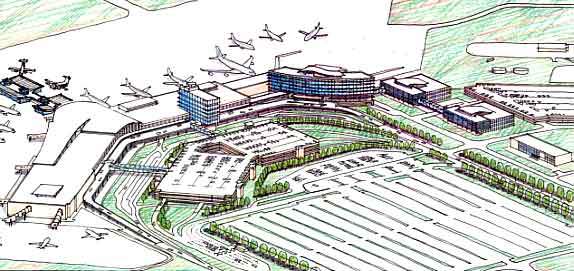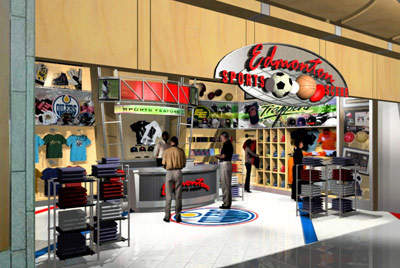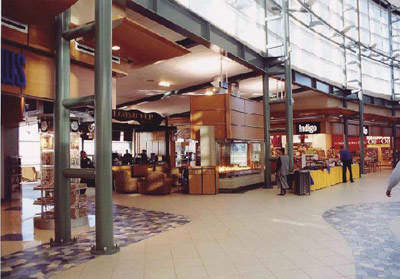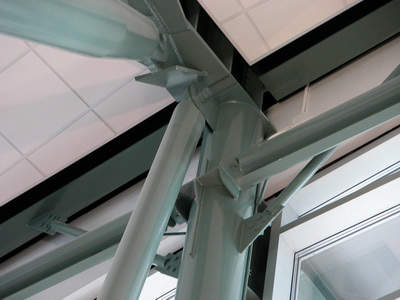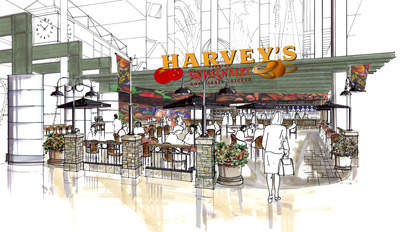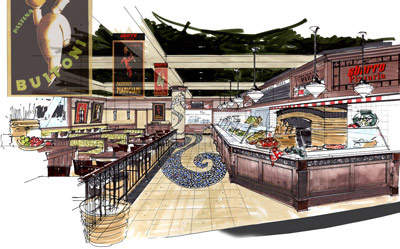Edmonton International Airport is situated about 35km (22 miles) south of Edmonton’s central business district. The airport is the primary air passenger and air cargo facility in Edmonton, Alberta, and a major hub for Northern Alberta and Northern Canada. The airport served six million passengers in 2007 and is operated by the Edmonton Regional Airports Authority (ERAA).
The original terminal at Edmonton International Airport was built in 1963 for a passenger capacity of 2.5 million, and is forecasted to have around nine million passengers passing through it by 2012. The airport completed phase three of a C$350m expansion in 2004 in order to accommodate the rising levels of traffic (expansion project ran from 1996 to 2004). It handled 6.08 million passengers and recorded 130,596 aircraft movements in 2010.
Edmonton Airport master plan 2035
In April 2011, the airport released a draft master plan that aims to double the airport’s existing passenger handling capacity by 2035. The plan includes the addition of a new runway and new gates at the airport by 2030. The plan also proposes the development of cargo facilities at the airport.
Edmonton airport project
The total project was completed in three phases, allowing the possibility of tweaking the project mid-course should requirements change.
Phase one included the parkade expansion and various smaller infrastructure and maintenance projects. Phase two involved the expansion of the south east terminal building by doubling its floor area.
The third phase, completed in 2004, involved the construction of the new central hall building between the existing terminal buildings. The two terminals are shaped together in a fashion akin to a chevron – ‘>’.
Parkade development (phase one)
The completed first phase ran from February to December 1998, and included a 1,800-space and a four-storey covered parkade. The parkade covered C$21.5m of the total C$42m (US$27m) cost of phase one.
It also included a number of roadway enhancements, new overhead signage, roof replacement over the north holdroom and ticket counter areas, ceiling repairs, a new parking toll plaza and 5,650m² of apron expansion.
In addition to parking services, the parkade also houses an enclosed car rental area and is connected to the terminal by a covered walkway. The parkade has the capability for further expansion of up to seven levels and more than 3,500 spaces.
South-east terminal expansion (phase two)
The second phase ran from February 1999 to December 2000 at a cost of C$127m, and included the development of a new 130,000ft² terminal located south-east of the original terminal building costing C$75m.
The terminal contract was carried out by a joint venture of PCL Construction Management Inc and Maxam Contracting. The architects were O’Neill Procinsky Architects and Kasian Kennedy.
The Edmonton Airport Southeast Terminal Expansion (also known as SETE) has a building footprint of approximately 130,000ft² and a total building area of about 300,000ft², including the arrivals area, departures area and the mezzanine level.
Substantial mechanical and electrical upgrades and additional equipment to the existing central utilities plant were included in the SETE project. The mechanical and electrical upgrades were designed to provide sufficient capacity to service the existing ATB, SETE and the new central hall (phase three).
Edmonton airport apron expansion
The project cost for phase two also covered the C$17m (US$11m) apron expansion for aircraft manoeuvring and parking, and additional roadway enhancements. The contract for the apron extension was won by Dufferin Construction.
Dufferin’s bid price was approximately C$1m (about US$0.67m) lower than the nearest competitor. The contract also involved ten sub-contractors, mainly local companies.
At the start of the bid, Dufferin estimated that around 85% of the value of the project would be sourced locally, although Dufferin itself is based in Ontario. Local sourcing was cited by Edmonton Airport as being important in its decision.
Central hall
In July 2001 the third C$43m phase was awarded to PCL Construction and Maxam; construction began in August 2001 and the hall opened in November 2003.
The contract consisted of a two-level 18m-high, 17,000m² central hall containing the centralised security, passenger amenities, commuter areas and ground transportation services. The central hall now connects the north and south terminals. The upper departures level features a 30ft-high curved ceiling, plenty of natural light, and design features that speed travellers along.
Security for the entire airport is centralised in the central hall, with six checkpoints designed for fast, efficient movement. The new commuter concourse, designed specifically for short-haul regional aircraft juts out from the central hall building towards the airside apron area, just 40m past centralised security. It features a large, open hold room with a view of apron operations (aircraft manoeuvring area) and escalator access to ground-level passenger corridors leading to six gates. The facility is expandable to ten gates.
By integrating the central hall with the existing terminals, the current airline check-in counters are already positioned adjacent to the centralised security area. Central hall provides an additional 14 Air Canada positions and the open concept hold room can seat 600 people.
An indoor observation area overlooks both the hold room and allows travellers to watch aircraft movements on the airport’s two main runways. A complete compliment of food and beverage services, a duty free store, a bookstore and specialty retail is located in the facility.
The central hall design incorporates the wing-effect overhead lighting concept, established in the Southeast Terminal Expansion. It can also save considerable money on air conditioning because of solar heating through large expanses of glass. The basement contains a huge, three-million-litre chilled water storage tank. The water is cooled at night when utility rates are low, then used for air conditioning during the day when utility rates hit their peak rates.
Empire Iron supplied and installed structural and miscellaneous steel for the building. The central hall was designed by a consortium of architects under the Edmonton International Airport Associated Architects (EIA3) name as a joint venture. The consortium was comprised of Stantec Inc, formerly Architectura Planning Architecture Interiors Inc (design architects), Barr Ryder Architects & Planners (managing architects) and Wood O’Neill O’Neill Architects Ltd (production architects).
Edmonton airport project sub-contractors
The sub-contractors of Dufferin Construction included Norellco Contracting Ltd of Edmonton (storm sewers), Selene Contractors of Edmonton (earthworks), Challenger Surveys of Edmonton (surveying), Wells Construction Ltd of Edmonton (granular pavement), MCL Contracting Ltd of Edmonton (electrical), Alberco Construction Ltd of St Albert, Alberta (MH/CB structures), Lynk Brand Fence of Spruce Grove, Alberta (fencing), Can West Cutting and Coring of Calgary, Alberta (concrete cutting), Sealtec Pavement Maintenance Systems of British Columbia (joint sealant) and Blast Deflectors of California, USA (jet blast wall).
Comstock Canada
Comstock Canada was responsible for the complete mechanical and electrical installation, including boilers, chillers, air conditioning, sprinklers, plumbing and drainage, 25kV power distribution, fire alarms, security systems, paging, lighting and controls.
Comstock, part of the Emcor group, was awarded a contract worth C$16m (US$11m).
Edmonton airport funding
The expansion was funded through money raised by an airport improvement fee, consisting of C$10 per departing passenger. This raised the in-Alberta rate from C$5 to C$10, while retaining the outside-Alberta fee at C$10 (similar to most other Canadian airports).
New Edmonton airport projects
In October 2007 a new $1.1bn expansion plan was approved for Edmonton. Phase one will see a new a 253,000m² apron expansion for the south terminal expansion. Phase two of the project will involve a large hammerhead shaped south terminal extension which will have 13 new gates, increasing the number of gates at the airport to 30.
Phase three of the project includes a new concourse that will link the new south terminal extension to the existing south terminal. The expansion, currently underway, is expected to be completed by 2012. The current north terminal office building and the NavCanada control tower are to be demolished to unify the two airport baggage systems and new offices and control tower will be constructed on the west side of the original terminal near gate 49.
Additional projects, some of which have been completed, include the parkade, which has undergone expansion to include an additional 1,000 spaces, increasing the number of spaces to 4,000. Completed in summer 2008, the expanded project encompasses 1,000 extra parking stalls through four levels, a plaza that facilitates easy entry, parking and exit as well as pay-and-go parking kiosks. The project cost $47m and Stuart Olson was the general contractor.
Other projects underway include:
- A 200-room Marriott Courtyard by Concorde Hospitality Enterprises Company has been proposed to be built adjacent to the original terminal
- New unified baggage system
- Runway upgrade for A380
- New International freight hub
New technology at the airport will include: common-use self-serve kiosks, common-use self-tag baggage drops, flow through check-in counters, NEXUS technology for security checks between US and Canada, pay-and-go parking and new common-use signage.

